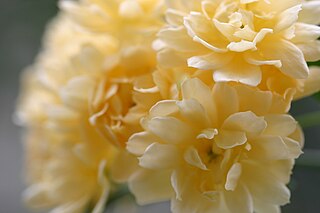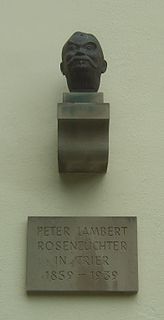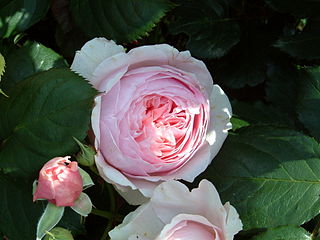
A rose is a woody perennial flowering plant of the genus Rosa, in the family Rosaceae, or the flower it bears. There are over three hundred species and tens of thousands of cultivars. They form a group of plants that can be erect shrubs, climbing, or trailing, with stems that are often armed with sharp prickles. Flowers vary in size and shape and are usually large and showy, in colours ranging from white through yellows and reds. Most species are native to Asia, with smaller numbers native to Europe, North America, and northwestern Africa. Species, cultivars and hybrids are all widely grown for their beauty and often are fragrant. Roses have acquired cultural significance in many societies. Rose plants range in size from compact, miniature roses, to climbers that can reach seven meters in height. Different species hybridize easily, and this has been used in the development of the wide range of garden roses.

Rosa 'Ispahan', also known as 'Rose d'Ispahan' and 'Pompon des Princes', is a clear pink, half-open kind of Damask rose, a type of garden rose introduced from the Middle East to Europe during the crusading 13th century. Its origin is unclear – it was introduced in the UK by the garden designer Norah Lindsay (1873–1948), but was probably developed in the early 19th century – probably in Persia. The cultivar is named 'Ispahan' after the city Isfahan in Iran, renowned for its gardens and roses, where the cultivar was apparently discovered in a garden.

Rosa gallica, the Gallic rose, French rose, or rose of Provins, is a species of flowering plant in the rose family, native to southern and central Europe eastwards to Turkey and the Caucasus. It was one of the first species of rose to be cultivated in central Europe.

Rosa banksiae, common names Lady Banks' rose, or just Banks' rose, is a species of flowering plant in the rose family, native to central and western China, in the provinces of Gansu, Guizhou, Henan, Hubei, Jiangsu, Sichuan and Yunnan, at altitudes of 500–2,200 m (1,640–7,218 ft). The rose is named for Dorothea Lady Banks, the wife of the botanist Sir Joseph Banks.

Rosa 'Mister Lincoln', also known as 'Mr. Lincoln', is a dark red Hybrid tea rose cultivar. Bred by Herbert Swim and Weeks Rose Growers in 1964, the rose was named an All-America Rose Selections winner in 1965.

Rosa × damascena, more commonly known as the Damask rose, or sometimes as the rose of Castile, is a rose hybrid, derived from Rosa gallica and Rosa moschata. Further DNA analysis has shown that a third species, Rosa fedtschenkoana, is associated with the Damask rose.

Rosa 'La France' is a pink rose cultivar found in France in 1867 by the rosarian Jean-Baptiste André Guillot (1827–1893). It is generally accepted to be the first hybrid tea rose. Its introduction is therefore also considered the birth of the modern rose. As the cultivar was not systematically bred, its hybrid parentage can only be speculated, but 'Madame Falcot' is considered as a possible parent.

A rose garden or rosarium is a garden or park, often open to the public, used to present and grow various types of garden roses or rose species. Designs vary tremendously and roses may be displayed alongside other plants or grouped by individual variety, colour or class in rose beds.

Peter Lambert was a German rose breeder from Trier.

Rosendals Trädgård is a garden open to the public situated on Djurgården, west of Rosendal Palace, in the central part of Stockholm, Sweden. Today, Rosendals Trädgård is open to public visitors in order to let visitors experience nature and to demonstrate different cultural effects on gardening through history. The purpose is to practise biodynamic agriculture and pedagogical education. The garden is owned and operated by the trust fund "Rosendals Trädgårds Stiftelse". In the area known as Rosendals Trädgård there are also, except from the garden: "Plantboden", a gardening shop where the customers can find everything that's useful in a garden, "Trädgårdsbutik", a shop where the customers can buy fresh vegetables cultivated in the garden at Rosendal. The maybe most visited shop is the famous bakery, which carries the same name as the garden, "Rosendal Trädgårds bakery". Visiting Rosendals Trädgård, one has a great opportunity to experience locally cultivated and produced phenomena and items.

Rosa 'Old Blush', also known as 'Parsons' Pink China', 'Old Blush China', 'Old China Monthly', is a China rose and has been cultivated in China for over a thousand years. It derives from Rosa chinensis, and is generally accepted as the first East Asian rose cultivar to reach Europe. It is recorded in Sweden in 1752 and in England before 1759, but was probably cultivated in China for several centuries. It is believed to be the rose which inspired the song The Last Rose of Summer by the Irish composer and poet Thomas Moore. It is also known as Parsons' Pink China, named after Mr Parson who introduced it commercially to the UK in 1793.

Pedro Dot (1885–1976) was a Spanish rose breeder.

Garden roses are predominantly hybrid roses that are grown as ornamental plants in private or public gardens. They are one of the most popular and widely cultivated groups of flowering plants, especially in temperate climates. Numerous cultivars have been produced, especially over the last two centuries, though roses have been known in the garden for millennia beforehand. While most garden roses are grown for their flowers, some are also valued for other reasons, such as having ornamental fruit, providing ground cover, or for hedging.

Rosa fedtschenkoana is a species in the plant genus Rosa in the family Rosaceae. It is native to the foothills of the Ala Tau, Tian Shan and Pamir-Alai mountain ranges in central Asia and northwest China. It is named after Olga Fédchenko, a Russian botanist. It is deciduous, forming a bushy and suckering shrub up to 2.5 metres high and as much across. The branches are covered in many prickles, many of which are fine and straight, but some are thicker and slightly hooked. The pinnate leaves are pale greyish green in colour and have usually between 7 and 9 leaflets. The flowers are white, up to 5 cm across, and are borne singly or in small clusters at the tips of the branches throughout the summer months. The flowers' scent has been described as being "like 'Hovis' [brown] bread with a little blackberry jam". The flowers are followed by small, pear-shaped, bristly orange-red fruits.

Rosa 'Arthur Bell',, is a yellow rose cultivar, bred by Sam McGredy IV in Northern Ireland in 1964. The rose has won numerous awards, and is popular in England and Northern Europe.

Rosa'Constance Spry' is a light pink shrub rose introduced into Great Britain in 1961. It is the first rose cultivar commercially developed by British rose breeder, David C.H. Austin. 'Constance Spry' was introduced at a time when the shrub rose was out of style, the hybrid tea rose being the most popular rose with gardeners. The new cultivar renewed the popularity of the more old fashioned type of rose.

Rosa 'de Rescht' is a Portland Damask rose introduced by English gardener Nancy Lindsay in 1945. In the first part of her book The Genus Rosa, Ellen Willmott described a rose that is known by the Gilaks as "Gul e Reschti", which is probably the same as Rose de Rescht.
The All-America Rose Selections (AARS) is an award that was given annually, from 1940 to 2013, by the American rose industry to an outstanding new rose variety. The AARS selection was regarded as the most prestigious rose prize in the United States for 73 years. AARS was discontinued after 2013, and was replaced by the new "American Garden Rose Selections" program.

















